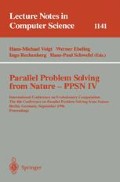Abstract
This paper presents the results of a parameter study of the Grand Deluge Evolutionary Algorithm, whose special features consist of local interactions between individuals within a spatially structured population and a self-adjusting control mechanism of the selection pressure. Since both ingredients are parametrizable this study aims at the identification of the significance and sensitivity of the parameter settings with regard to the performance of the algorithm, especially under the transition from one- to two-dimensional neighborhood patterns.
Preview
Unable to display preview. Download preview PDF.
References
T. Bäck. Evolutionary Algorithms in Theory and Practice. Oxford University Press, New York, 1996.
G. Borgefors. Distance transformations in arbitrary dimensions. Computer Vision, Graphics, and Image Processing, 27:321–345, 1984.
G. Dueck. New optimization heuristics: the great deluge algorithm and the record-to-record travel. Journal of Computional Physics, 104:86–92, 1993.
D.E. Goldberg. Genetic Algorithms in Search, Optimization, and Machine Learning. Addison Wesley, Reading (MA), 1989.
M. Gorges-Schleuter. ASPARAGOS: an asynchronous parallel genetic optimization strategy. In J.D. Schaffer, editor, Genetic Algorithms, Proceedings of the 3rd International Conference on Genetic Algorithms, pages 422–427. Morgan Kaufman, San Mateo, 1989.
S. Khuri, Th. Bäck, and J. Heitkötter. The zero/one multiple knapsack problem and genetic algorithms. In E. Deaton, D. Oppenheim, J. Urban, and H. Berghel, editors, Proceedings of the 1994 ACM Symposium on Applied Computing, pages 188–193. ACM Press, New York, 1994.
H. Mühlenbein, M. Gorges-Schleuter, and O. Krämer. Evolution algorithms in combinatorial optimization. Parallel Computing, 7:65–88, 1988.
M.E. Palmer and S.J. Smith. Improved evolutionary optimization of difficult landscapes: Control of premature convergence through scheduled sharing. Complex Systems, 5:443–458, 1991.
G. Rudolph. Parallel approaches to stochastic global optimization. In W. Joosen and E. Milgrom, editors, Parallel Computing: From Theory to Sound Practice, Proceedings of the European Workshop on Parallel Computing (EWPC 92), pages 256–267. IOS Press, Amsterdam, 1992.
G. Rudolph. Convergence properties of canonical genetic algorithms. IEEE Transactions on Neural Networks, 5(1):96–101, 1994.
G. Rudolph and J. Sprave. A cellular genetic algorithm with self-adjusting acceptance threshold. In Proceedings of the First IEE/IEEE International Conference on Genetic Algorithms in Engineering Systems: Innovations and Applications, pages 365–372. IEE, London, 1995.
P. Spiessens and B. Manderick. A massively parallel genetic algorithm: Implementation and first analysis. In R.K. Belew and L.B. Booker, editors, Proceedings of the Fourth Conference on Genetic Algorithms, pages 279–286. Morgan Kaufmann, San Mateo, 1991.
J. Sprave. Parallelisierung Genetischer Algorithmen zur Suche und Optimierung. Diplomarbeit, University of Dortmund, Department of Computer Science, 1990.
J. Sprave. Linear neighborhood evolution strategies. In A.V. Sebald and L.J. Fogel, editors, Proceedings of the 3rd Annual Conference on Evolutionary Programming, pages 42–51. World Scientific, River Edge (NJ), 1994.
Author information
Authors and Affiliations
Editor information
Rights and permissions
Copyright information
© 1996 Springer-Verlag Berlin Heidelberg
About this paper
Cite this paper
Rudolph, G., Sprave, J. (1996). Significance of locality and selection pressure in the grand deluge evolutionary algorithm. In: Voigt, HM., Ebeling, W., Rechenberg, I., Schwefel, HP. (eds) Parallel Problem Solving from Nature — PPSN IV. PPSN 1996. Lecture Notes in Computer Science, vol 1141. Springer, Berlin, Heidelberg. https://doi.org/10.1007/3-540-61723-X_1032
Download citation
DOI: https://doi.org/10.1007/3-540-61723-X_1032
Published:
Publisher Name: Springer, Berlin, Heidelberg
Print ISBN: 978-3-540-61723-5
Online ISBN: 978-3-540-70668-7
eBook Packages: Springer Book Archive

